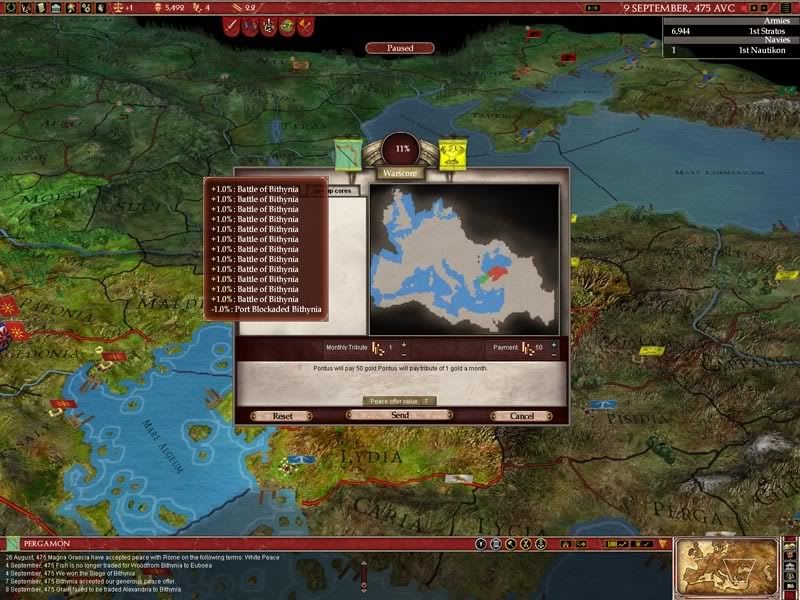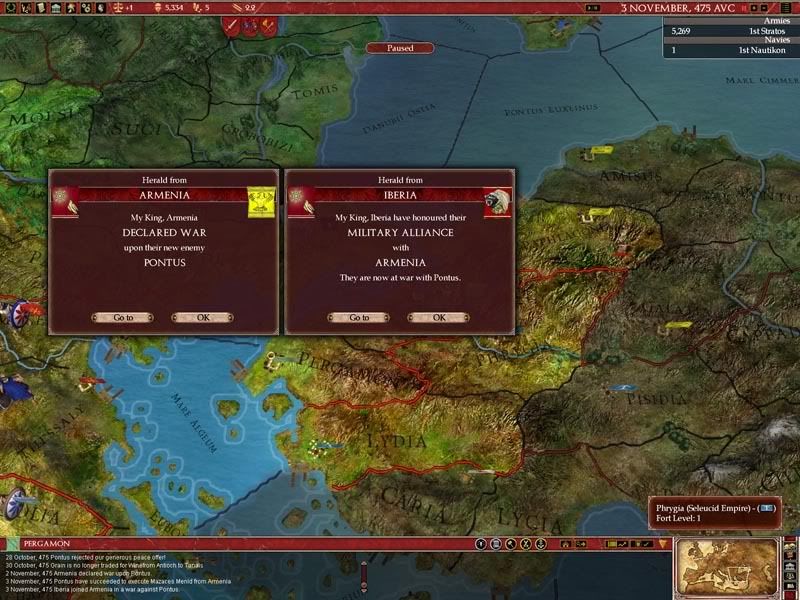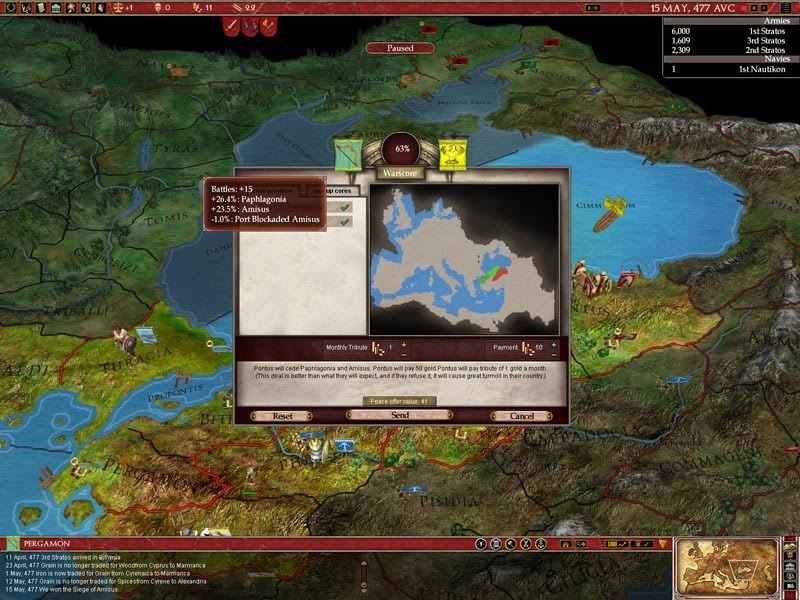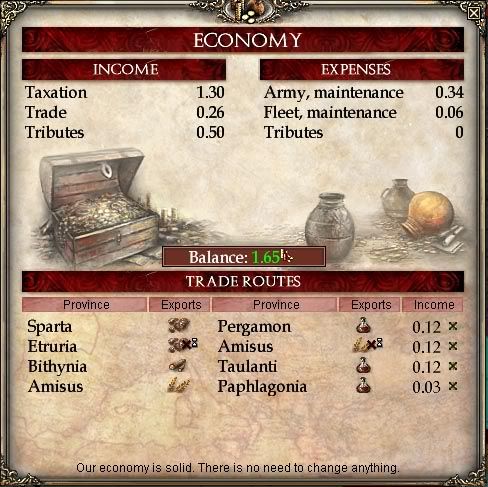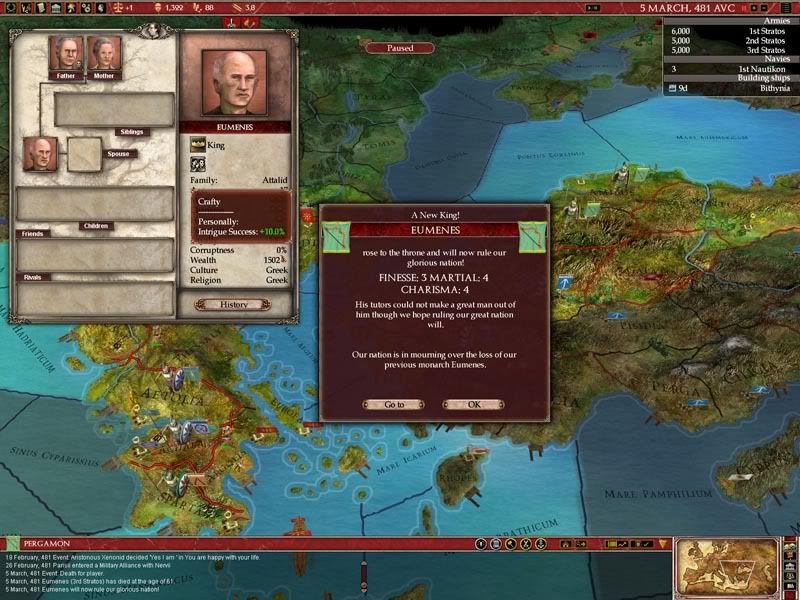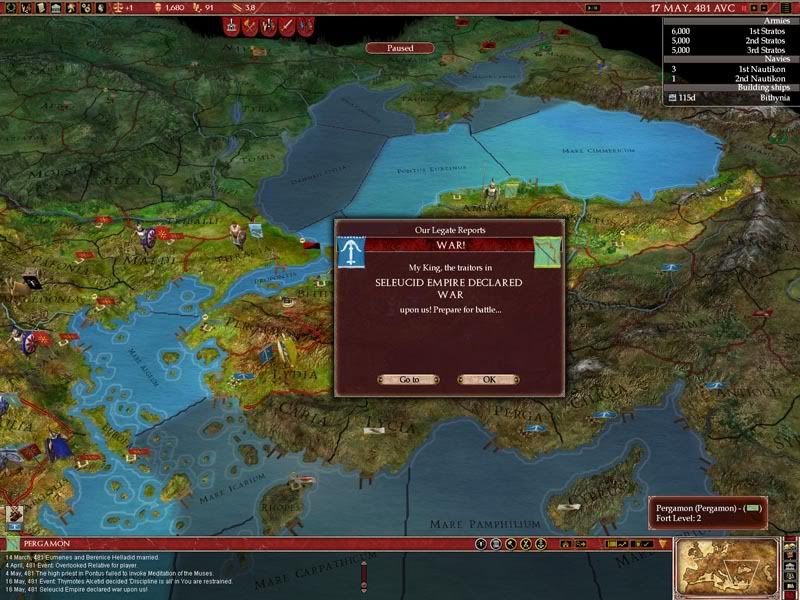5 regiments would again test the sieging Pergamese army on April 19th, 482 AVC. The 1st Stratos, backed by the 3rd Stratos having arrived via the well maintained roads just days prior, strode confidently into battle. The enemy strategos, Pelopidas Alcetid, out-matched in every way found himself captured as his men withdrew in a panic after a day of fighting. The casualties numbering 2,376 dead Seleucid soldiers (47.52%) and just 92 dead soldiers of Pergamon.
The months of May, June and September would see some of the heaviest fighting in the war. The 1st and 3rd Stratos in Phrygia would be under constant attack from Seleucid forces. In May, the battles resulted in 9,414 dead or wounded Seleucid soldiers (75.53%) and 1,300 dead or wounded Pergamese soldiers (8.95%). Aiding the 1st and 3rd Stratos in May was 2 locally raised regiments, allowing for them to be utterly destroyed before they could leave the area for no loss to the men under Aristonous' command.
June was slightly less bloody, with a series of engagements resulting in 4,380 dead Seleucids (58.7%) and 936 Pergamese dead or wounded (6.9%). Again, 2 locally raised regiments were destroyed wholesale this month at no cost; allowing Aristonous a measure of ease in the field of battle.
June also saw Pontus defaulting on its tribute to Pergamon. While this gave us justified cause to move into Pontus, the troops simply could not be spared. The only soldiers capable of such an action was the 4th Stratos; the mercenaries in charge of keeping the peace in Bithynia, Paphlagonia and Amisus.
In September, two long engagements occurred on land in Phrygia. Aristonous would continue to lead the 1st and 3rd Stratos to victory and see his forces depleted again and again with little hope of replenishing them. In total, 11382 4,232 (37.18%) Seleucid soldiers would lay dead and the Pergamese forces would be depleted another 2,593 men (19.6%). At sea, however, Attalus would find himself engaged with the larger naval fleet of the Seleucids. His 50 triremes out-numbered drastically by the 110 arrayed against him in the Mare Aegeum. The loss suffered would be the first loss suffered by the Pergamese forces in the war, and sent the heavily damaged Pergamese navy into port and yield full naval dominion to the Seleucids.
December would see the peasants of Bithynia revolt and the barbarians in Macedonia proper move onto the Aetolians, while the Seleucid Empire laid sieges in both Argolis and Euboea, as well as the majority of the Macedonian fleet sunk off the coast of Sparta.
On January 13th, 483 AVC, the 1st and 3rd Stratos in Phrygia would be once more be forced into battle as another Seleucid relief army was deployed. Aristonous was quick to react to the situation and caught the unknown sergeant commanding the host of 12 Seleucid regiments off-guard. He drove the attack home and sundered the relief army, breaking its morale and sending it limping home to Psidia. A mere 156 Pergamese soldiers would die in the brief battle, while 2,627 Seleucid men died (23.56%).
On February 3rd, the 3rd Stratos, led by Proctus Zosimid, reached Bithynia and raised the siege of Nicaea by the peasant rabble before the 4th Stratos could reach it. 892 peasants would be slain, the rest of their 5,000 dispersing throughout the province. The 3rd Stratos, however, would suffer 927 dead or wounded, a third of its force. Proctus quickly ordered his men to march back to Phrygia to re-position them in case they were needed, and the 4th Stratos returned to idly garrisoning in Paphlagonia.
March would see Attalus leading the 1st Nautikon from the port of Pergamum to catch a single, damaged, series of triremes. Sinking it he set out along the coast of Greece on patrol, hoping not to run afoul of the larger Seleucid fleet.
At the news of 18 regiments being sent from Psidia to Lydia, the 1st Stratos was sent to reinforce Selagus' position. The 2nd Stratos would have been out-numbered by more than 3:1, and the numbers of the 1st Stratos, even depleted as it was, would help ensure a favourable outcome, by making the odds 6:5 in favour of the Seleucids. As the 18th of June arrived and battle was met in Lydia, this would be proven both true and false. The battle would be lost as morale shattered and Ephesus put under siege while the 1st and 2nd Stratos were withdrawn to Pergamon. However, the victory had cost the Seleucid army dearly; 13,428 Seleucid soldiers (74.5%) lay strewn on the field, dead or dying. Of the retreating Pergamese forces, 4,388 (29.45%) lay dead amidst their enemy.
They may have won the battle, but this would be a Pyrrhic victory if there was ever one.
As soon as the 1st and 2nd Stratos arrived in Pergamon they regrouped and headed back to Lydia to raise the siege of Ephesus. Hoping to catch the Seleucid force still shattered and weak, all haste was made. On September 2nd they would raise the siege successfully and crush the Seleucid force; killing 1,517 of the remaining 2,831 besiegers (53.59%) and suffering light losses (193 dead).
Word arrived, however, of a Seleucid army making for Phrygia to raise the siege while the 1st Stratos was out of position and the badly under-strength 3rd Stratos maintained the siege. Using the roads of Lydia to his advantage, Aristonous headed to Phrygia hoping to be in time to support the 3rd Stratos when the 5 regiments of Seleucid arms arrived in early November.
Arriving on November 3rd, the same day as the Seleucid forces under the command of Pausanias Xenonid, Aristonous was forced to yield joint command to Proctus Zosimid; giving the Seleucid's the advantage. Due to Aristonous' timely arrival, however, Pausanias was forced to fight on terrible ground relinquishing much of what he gained in tactical superiority over Proctus.
Outnumbered and pressured from both sides, Pausanias and his army broke before that of the 3rd Stratos and fled the field, suffering 1,773 casualties (37.67%) and the 1st and 3rd Stratos suffering minor losses of 292 dead (2.94%), gaining Proctus much popularity with the people of Pergamon.
Finally, on December 17th, 483 AVC, Amorium, capital of Phrygia, threw open its gates after an astounding 871 days.
Attempts to have peace declared following this glorious achievement, however, would be stymied by Pergamese demands for reparations and hampered by Macedonian losses; with Euboae in Seleucid hands, it under-cut the possibility of peace despite continuous victories by the Pergamon army. Macedonia, however, was brought to a separate series of peace negotiations with the Seleucid Empire, and on March 6th, 484 AVC, they signed a white peace accord with the Empire, returning Euboae to their control in exchange for them withdrawing from the conflict and leaving Pergamon to stand alone.
Macedonia out of the war, the Seleucid Empire began demanding a similar white peace with Pergamon -- likely figuring that with Pergamon standing alone, they would be enticed to settle. However, with the death of so many brave soldiers and with the countless victories piled up against the Seleucid Empire, Eumenes II knew it would be political suicide to settle the war without some concessions. Additionally, few soldiers appeared to be on the horizon; the Seleucid Empire was falling into a manpower crunch fueled by repeated rebellions deep inside their territory. As for losing Macedonia as an active ally in the conflict... little sleep was lost. Macedonia had been devastated by barbarian raids into their lands over the last five years. Their military was weak and their lands only slowly recovering; their navy having largely been destroyed earlier meant what little support they might have once given Pergamon was long since gone.
This coupled with repeated losses on the field to Pergamon meant their position was weakening. Eumenes II smelled blood in the water and pressed for active concessions of Lydia and tribute from the mighty Seleucids. Every offer was rebuffed on both sides of the negotiating table and the war continued to drag on. War exhaustion continued to mount for both -- Eumenes II, however, was convinced any rebellions in Pergamese territory could be contained due to the size of it holdings. He was wagering the Seleucid Empire would have much more difficulty.
The Seleucid Empire launched another attack on the forces in Lydia, likely hoping to catch the Pergamese split. Once again, however, the road system allowed the 1st Stratos to maneuver quickly enough to respond and reach Lydia before the Seleucid force could. Outnumbering the Seleucids by almost four thousand men, the back of yet another Seleucid incursion was broken and the army sent into retreat towards Psidia. The battle saw 3,706 (40.96%) dead and wounded for the Seleucid Empire and 1,765 (13.73%) dead Pergamese.
Tired and weary of the defensive force, Aristonous launched a counter attack, leading the 1st and 2nd Stratos from Lydia into Psidia, hoping to push the Seleucid Empire from yet another province and strengthen the hand of Pergamon at the negotiating table.
His forces arriving on July 30th, Aristonous quickly engaged the nearby Seleucid force in a series of battles that he drew out intentionally over the course of a few days, seeking to destroy another Seleucid army completely. He failed to destroy it, however, as only 2,743 of 7,092 (38.68%) were killed in action. He did keep losses of his own forces to a minimum, though; losing just 168 men in the fight to push the Seleucids from Psidia and laying siege to its capital of Sagalassos.
On March 9th,485 AVC, with the war against the Seleucid Empire continuing to drag on with little action, the 4th Stratos would engage a force of peasants in Paphlagonia arriving from Galatia where they had successfully taken the province from Armenia. The force would be destroyed with minimal losses (62 dead or wounded). Then, on June 2nd, peasants within Paphlagonia would rebel forcing the 4th Stratos to harshly put it down, sustaining just 3 dead.
The 15th of October of that same year would see Sagalassos open its gates to our soldiers and another province falling into our hands as the war continued to drag on with no headway made at the negotiating table. The siege had lasted 440 days, and with no combat action in that time, the depleted ranks of the 1st, 2nd and 3rd Stratos' had been refilled slightly.
The dawn of November saw Macedonia declare war on Illyria and their request for aid from Pergamon. Embroiled in a war of our own, and knowing we remained a single mis-step from losing everything against the super power, we decided on our contribution to the war on Illyria; Euemenes II dispatched a courier to cross the Mare Aegeum and deliver to Macedonia the finest of wines within the Pergamon nation. The gift lightened the spirits at court within the great halls of Pergamum and caused more than a single citizen to be briefly distracted from the on-going war with the Seleucid Empire.
That lifted mood was brought back to earth in late November when a Seleucid army entered Psidia and engaged Aristonous' forces to a series of battles. They inflicted only minor casualties upon Pergamon's army (250 dead of over 16,000 combined arms of the 1st, 2nd and 3rd Stratos), but morale amongst the 1st Stratos in particular was at an all time low, with the men barely able to stand against the Seleucid army. Still, 3,500 dead or wounded (45.71%) Seleucid soldiers were left behind when the army was chased off towards Seleucid territory.
Morale remained threadbare when another Seleucid army composed of 8,000 engaged the three Stratos' on the 18th of December. The Pergamon army would be once more served brilliantly by Aristonous who drove home another victory with a ferocious attack on the center of Seleucid lines only moments into the battle. By quickly shattering the morale of the enemy and driving them from the field, he preventing his own lines from crumbling from exhaustion and fear. 159 dead Pergamese soldiers were wept over by brothers-in-arms, while 3,293 (41.16%) dead Seleucid men were abandoned on the fields as the remaining withdrew to safer lands.
Pontus would sign a military alliance with the Seleucid Empire on the 30th of December, but not join the conflict -- an unsurprising act given the nation remained bankrupt and only slowly working itself out of debt, and continued to lack a standing army.
Seeing a weakness in Seleucid deployment, Aristonous ordered Selagus and Proctus to take their forces and lay siege to Perga. Their forces would arrive on April 2nd, 486 AVC. The province and its cities lacked a standing army to defend it and siege-works were constructed immediately outside the capital of Perga.
Additionally, a 5th Stratos was being formed from more mercenaries, to be stationed in Phrygia and guard against insurrection in either Phrygia or Lydia while the main armies expanded the front in Psidia and Perga. The coffers continued to be drained slowly, proving again and again the immense importance of the war against Bithynia and Pontus over a decade earlier.
On the 14th of July, 486 AVC, while grumbling about a business venture gone south and the personal finances lost, Eumenes II heard the tragic news; Selagus Zosimid, Strategos of the 2nd Stratos had died suddenly and the age of 49. The loss of the brilliant general caused minor panic amongst the people. It was only the knowledge that Aristonous remained alive and well on the frontier that kept the peace. With a heavy heart, Eumenes II ordered the merging of the 2nd Stratos into the 3rd Stratos, with Proctus remaining as its Strategos and now in command of the siege on Perga.
Then, while the nation mourned the loss of Attalus I, Kybernate of the 1st Nautikon, news arrived the siege of Perga had ended with the city opening its gates on the 10th of February, 487 AVC, after 316 days.
Another province is taken, in spite of the loss of Selagus Zosimid, celebrated Strategos of the 2nd Stratos.
With Perga secured, Aristonous ordered Proctus to march on Cilicia to force the Seleucid troops there to remain in place while he took the fully replenished 1st Stratos and its 11 regiments into Cappadocia and secure the isolated Seleucid province. If they make Cilicia the front-line, they would force the Seleucid Empire to enter through that province in any attempt to retake any of the captured territories, unless they could secure military passage through Armenia (which had finally retaken Galatia from rebels).
The 1st Stratos would arrive in Cappadocia on the 6th of June and be immediately set upon by the Seleucid army defending the province. Under the command of Philotheos Omirid, the Seleucid's pushed the 1st Stratos into poor position on questionable terrain. The two forces, of roughly equal number, would battle for days in a series of engagements where Philotheos continued to catch Aristonous by surprise and direct the ebb and flow of battle.
After 6 days of fighting, and just as Proctus would lead the 3rd Stratos into Cilicia, Aristonous met with defeat; morale crumbling and his men bitter, he withdrew them back to Psidia. The defeat was humbling and costly; 4,954 (45.04%) Pergamese soldiers dead or dying with a nearly identical number of Seleucid hoplites and supporting forces dead (4,339 of 10,800 -- 40.18%).
Proctus, however, would see bitter victory over a nameless sergeant in Cilicia after 5 days of light combat. The Seleucid army would withdraw towards Antioch, leaving a mere 245 (8.17%) dead behind, while Proctus' victorious 3rd Stratos suffered 1,475 (19.02%) dead or wounded. The siege of Soli, capital of Cilicia, began.
The tide seemed to be turning. With the defeat of Aristonous at the battle of Cappadocia the best general Pergamon had was proven fallible, and the costly victory in Cilicia left the southern front weakened and the possibility of a successful Seleucid reprisal looming on the horizon. Eumenes II, for the first time in ages, pondered the war with worry and doubt gnawing on him. The people were exhausted, the nobility was suffering financially, and the armies were once more drastically under-manned. The 1st and 3rd Stratos, the offensive wings of the army barely sitting above half-strength with the 4th and 5th Stratos anchored in defensive position lest rebellions be allowed to go unchecked should they occur.
It seemed, for all intents and purposes, the momentum of the Pergamese military was at an end -- that the fortunes of war had begun to shift some 6 years after the war had begun.





